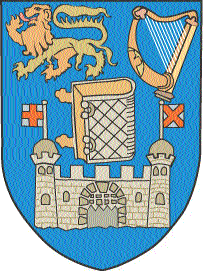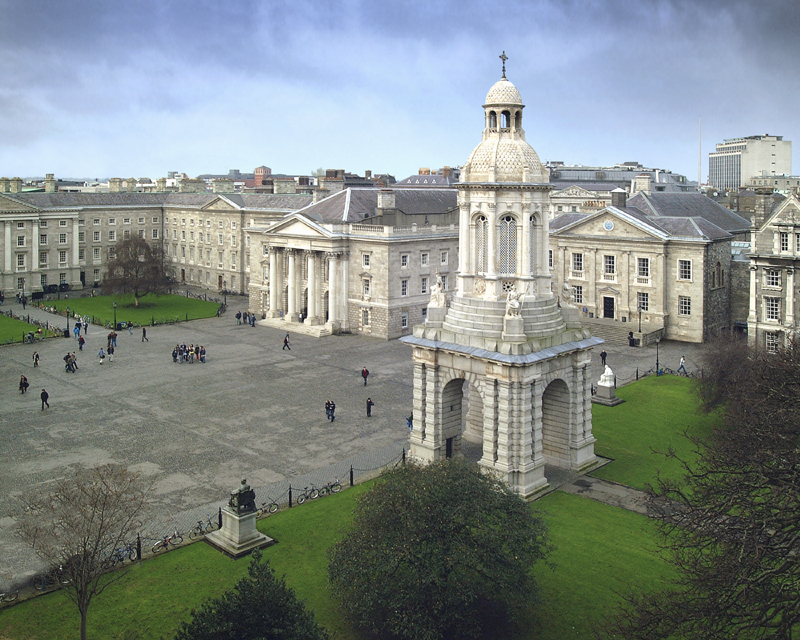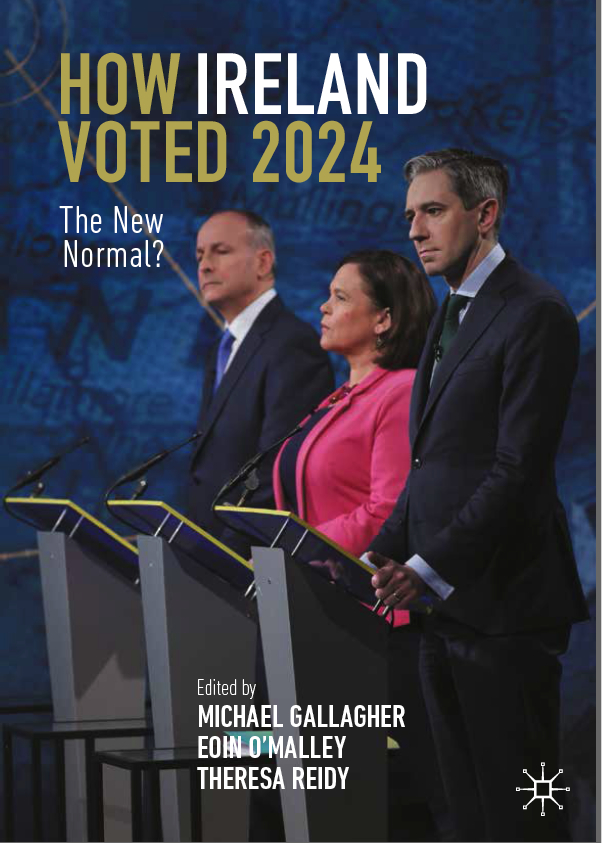
Department of Political Science, Trinity College Dublin
Michael Gallagher

 |
Department of Political Science, Trinity College Dublin Michael Gallagher |
 |
How Ireland Voted 2024
web page
This page contains information about the book How Ireland Voted 2024: the new normal?, an analysis of Ireland's general election of November 2024. It has been edited by Michael Gallagher, Eoin O’Malley and Theresa Reidy and is due to be published in September 2025 at a very reasonable price. It’s the tenth volume in the How Ireland Voted series (the first was about the 1987 election). For publication details see the Springer / Palgrave Macmillan site or the Amazon site. For more information on the election, click here.

| Among the questions addressed |
| What were the key events and developments of the period between the 2020 and 2024 elections? See chapter 1 |
| Was voting at Ireland’s 2024 local and European elections determined by election-specific factors or by national political issues? See chapter 2 |
| ‘Politicians promise everything but deliver nothing.’ Is that true? See chapter 3 |
| Were candidates at 2024 election selected by party elites or by grassroots members? Any significant changes in backgrounds of those selected? See chapter 4 |
| Based on their 2024 manifestos, how do the Irish parties line up on left–right spectrum? Full analysis (and some amazing graphics). See chapter 5 |
| Which party strategies were successful at 2024 Ireland election, and which ones weren’t? See chapter 6 |
| Implications of social media usage at 2024 Ireland election for future of media regulation? See chapter 7 |
| How do candidates themselves go about trying to get elected? Revealing accounts by candidates. See chapter 8 |
| Do TDs have an incumbency bonus at Irish elections? Large number of FG retirements in 2024 enables this to be assessed. See chapter 9 |
| Did some parties respect the letter but not the spirit of candidate gender rules at 2024? There was no formal transfer agreement between FF & FG at Ireland 2024 election, but did voters for one tend to transfer to the other? See chapter 9 |
| How did FF & FG maintain support in 2024 election despite costs of governing? What role did immigration play in voting behaviour? See chapter 10 |
| Are demographics playing a stronger role in determining Irish voting than in past? Which has greater effect on voting behaviour, class or age? See chapter 10 |
| ‘Far right’ flourishing in many countries, conditions in Ireland seemed favourable for them, but no sign of breakthrough at 2024 election. Why not? See chapter 11 |
| How was government put together in wake of 2024 Ireland election? See chapter 12 |
| Was overall story of Ireland 2024 election one of continuity or of change? See chapter 13 |
Reviews / endorsements
Back cover endorsements:
David McCullagh, author, journalist and news presenter, RTÉ
‘The indispensable guide to the election: invaluable statistics, revealing insights, astute analysis. A must-read for those interested in Irish politics.’
Mary Regan, Political Editor, Irish Independent
‘The How Ireland Voted series is the go-to guide for each election, used to analyse the last election and prepare for the next. How Ireland Voted 2024 continues in that tradition with fascinating data, analysis and coverage of the whole election. Indispensable.’
Professor Georg Lutz, University of Lausanne
‘The book offers fascinating insights into party and voter dynamics during the 2024 Irish elections, all within the unique Irish party and electoral system. It’s exciting to see so many political scientists building on the growing wealth of high-quality research data to explore electoral and campaign behaviour in such depth and detail.’
The book's contents:
| Title | Author(s) | Chapter abstract | |
| Front matter | Preface, Foreword (by Michael Marsh), lists of tables and figures, chronology of the election, colour photograph section | ||
| Chapter 1 | The Road to the Election | Gary Murphy | This chapter outlines the background to the election. It surveys the main developments of the period 2020–24, covering the lifetime of the historic Fianna Fáil, Fine Gael, Green coalition government. The government was formed in exceptional circumstances during the Covid-19 pandemic and, despite two early ministerial resignations, functioned relatively smoothly during its lifetime. It was the first time Fianna Fáil and Fine Gael, the two parties that had dominated the state since its foundation, governed in coalition. One of its main features was the introduction of the concept of 'rotating Taoiseach' under which, halfway through the government's tenure, Fianna Fáil's Micheál Martin gave way to Fine Gael's Leo Varadkar. The government was rocked by the unexpected resignation of Varadkar, as Taoiseach and leader of Fine Gael, in April 2024 just weeks after it had decisively lost two referendums on family and care. Party competition was fierce during these four and a half years and saw Sinn Féin surge significantly ahead in opinion polls before fading throughout 2024. By the time the election was called nobody could be sure what its outcome would be given the volatility of the electorate. |
| Chapter 2 | The Local and European Elections of 2024 | Lisa Keenan | While local and European Parliament (EP) elections are characterised as 'second order', political parties still carefully study the results of these contests and use them to inform their strategies in advance of general elections. In 2024, the proximity of the June local and EP elections to the general election enabled parties to apply the lessons they had drawn from those contests less than six months later. Using data from the Local Election Candidate Study (LECS) 2024 and the National Election and Democracy Study 2024, this chapter examines the local and EP elections. It first considers the contests, outlining the campaigns and the results, before considering the conclusions took from these contests as part of their preparations for the upcoming general election. |
| Chapter 3 | The Record of the Outgoing Government: Pledge Fulfilment in a Time of Plenty | Rory Costello and Seán Ó Maoilriain | In this chapter we provide a comprehensive assessment of the outgoing government's record of election pledge fulfilment. We identify all of the concrete promises contained in the 2020 manifestos of the three government parties and examine what happened to these pledges subsequently, including whether they were included in the programme for government and whether they were fulfilled by the end of the Dáil term. Contrary to popular belief, we find that the Green Party did not exert an outsized influence on government policy; rather, the number of pledges delivered by each party was roughly proportionate to its size. We also compare the pledge fulfilment record of this government with evidence from previous terms, and find that the 2020-24 government enacted a much larger number of election pledges than its predecessors. This reflects the favourable economic circumstances and the well-documented tendency for coalition governments to seek to avoid compromises when resources permit. |
| Chapter 4 | Candidate Selection: Many, Many More of the Same Kinds of Candidates | Theresa Reidy | Voters were presented with a very wide array of candidates from which to make their choice in 2024. No fewer than 686 candidates appeared on ballot papers, a remarkable increase of 155 candidates on the previous election. This chapters explores the candidate strategies adopted by the main parties and it also outlines the rules and procedures which govern the selection of candidates. There is an element of internal party democracy in how all parties make decisions. Constituency level selection conventions are convened but the decisions taken by members are heavily constrained by party elites who decide on the number of candidates to be selected and any additional criteria to be applied such as gender and geography. Party elites retain powers to add further candidates and de-select any candidates they deem unsuitable. Collectively the addition and de-selection powers are essential for parties to manage the legal and competitive demands of the system but ultimately, they also bypass members and marginalise their overall contribution to candidate selection. Finally, the chapter presents a profile of the candidates that contested the election documenting the occupational background and political experience of candidates. |
| Chapter 5 | What the 2024 Manifestos Reveal: Issue Salience and Left–Right Positions | Gail McElroy and Stefan Müller | This chapter examines the policy focus and policy positions of the major political parties competing in the 2024 Irish general election. Utilising state-of-the-art machine learning techniques, the chapter first explores the salience of 18 different policy areas in over 17,000 sentences from nine party manifestos, finding that housing and health policy dominate the 2024 election manifestos. Comparing changes in policy focus over time, the chapter next maps the rise of housing and health policy across the four elections since 2011. The chapter then examines the left-right positions derived from party manifestos, demonstrating the existence of a clear left-right dimension of competition in Irish politics. The chapter further finds that Fine Gael and Fianna Fáil have moved leftwards. The space they have left behind on the right of the political spectrum has been claimed by Independent Ireland and Aontú. |
| Chapter 6 | Campaign Strategies: the Inside Story of How Election 2024 was Fought | Harry McGee | Election campaigns seem to matter. They are what politicians and professional observers put a lot of emphasis on. Even policy choices are made in anticipation of an election campaign. 2024 was a year of challenges, and churn for political parties led to some dramatic changes and pivots in policy and strategy as a general election loomed. Those strategies rarely survived first contact with the enemy. This chapter discusses those strategies and which ones were dropped or adapted, what new ones were adopted in the face of changing circumstances, and whether any of those strategies or campaigns determined the outcome of the election. |
| Chapter 7 | Digital Media Trends and Testing Regulatory Structures | Eileen Culloty, Ciarán O’Connor and Jane Suiter | The 2024 Irish general election marked a turning point in regulation, with legislative measures beginning to address the challenges posed by digital communication. The removal of the broadcasting moratorium reflected the evolving nature of election coverage, acknowledging the need for real-time, reliable reporting in an era of continuous digital content. Despite this progress, regulatory disparities remain with different rules applying to broadcasting, print, and online media. Using data from Newswhip, this chapter reports on the contrasting priorities of mainstream media and social media engagement, revealing significant discrepancies in issue salience. While housing dominated journalistic coverage, online discourse was driven by polarising topics such as immigration. These findings underscore the shifting power dynamics in election communication, where digital platforms shape public discourse in ways largely unaccountable to regulatory bodies. |
| Chapter 8 | Inside the Election: the Candidates' Perspective | Seven candidates who contested the general election to Dáil Éireann and one candidate who contested the Seanad Éireann election provide comprehensive accounts of their campaigns in this chapter and convey the reality of campaigning on the ground. They outline how they were initially selected as candidates, their experiences of door to door canvassing, the execution of their social media, postering and profile-raising plans, and the issues that voters raised with them. The candidates are drawn from the largest six parties, along with two independents. | |
| Chapter 9 | The Results Analysed: the Centre Strikes Back | Michael Gallagher | The chapter analyses vote shifts and seat gains and losses, assesses the performances of the parties, draws inferences from the pattern of vote transfers, and assesses the utility of the betting market as a results predictor. It considers the value of incumbency, and asks whether female candidates consistently under-perform compared with their male counterparts. It also analyses the composition of the new Dáil. Unlike its three predecessors, the election did not witness large changes in party strengths, a possible indicator that the party system has reached a degree of stability. The domination of the post-election government by centre-right parties and the mainly left-wing orientation of the opposition suggests that the party system may be moving towards a clearer left–right competition than Ireland has experienced in the past. The chapter also analyses the result of the election to Ireland's upper house, Seanad Éireann. |
| Chapter 10 | Voter Dynamics in the 2024 Election: Stability with Hidden Currents of Change | Kevin Cunningham and Johan A. Dornschneider-Elkink | This chapter examines how voters determined their choices in the general election. In a contest marked by apparent stability we observe considerable underlying volatility. Drawing on polling day survey data that capture the voters' own explanations for their choices we look at three key questions. First, why did Fianna Fáil and Fine Gael maintain such strong support despite typical costs of governing? Second, how did the shift away from Sinn Féin towards independents and smaller parties relate to the rising prominence of immigration. And, thirdly, how are the deeper dynamics, most notably the generational divide, reshaping the Irish electorate beneath the surface of electoral continuity? To answer these questions and provide further insights on the 2024 vote we explore how demographics, values, issues, appraisals of the government and the economy as well as campaign and candidate-based drivers have influenced voting behaviour. |
| Chapter 11 | Immigration and the 'Far Right' in the Election | Jonathan Arlow and Eoin O’Malley | The ongoing protests at asylum accommodation centres in 2023 and 2024, including a riot in Dublin city centre, seemed relevant to the relatively strong electoral performance of conservative ethnonationalist or 'far right' candidates in the 2024 European and local elections. The conditions seemed ripe for a breakthrough for an explicitly anti-immigrant party or candidates. Yet this did not happen. In this chapter we offer some potential explanations for this failure, noting that the political system shifted attention and rhetoric in response to the elections in June, and so by November the issue of immigration was much less potent. However it is the case that political discussion of immigration is now much more common than it once was, suggesting the liberal consensus on immigration is broken. |
| Chapter 12 | Continuity with Change: Government Formation in 2025 | Eoin O’Malley | On paper the results of the 2024 Irish general election signalled continuity. That was also true in government formation. The main centrist parties that had traditionally dominated Irish politics, Fianna Fáil and Fine Gael, entered the election seeking a return of their government. The two parties came close to an overall majority. Thus they could continue their coalition, replacing the Green Party with several independent TDs. That small change might indicate a slight but important ideological change in direction for the government, and sets up a clearer ideological divide in the 33rd Dáil. |
| Chapter 13 | The election in context: has Irish politics really changed? | R. Kenneth Carty | The public face of Irish democracy appears to have dramatically changed from the predictable patterns that characterised it over most of the twentieth century. Gone is the easy dominance of Fianna Fáil, operating as the country's natural governing party, to be replaced by fragmented multi-party competitions. Decades of stable majority governments have been replaced by complex coalition bargains reflecting shifting alliances. Yet, in many other ways, familiar patterns of political organisation continue to drive unchanging electoral dynamics, producing Ireland's distinctive representative politics. This chapter seeks to discover whether Irish politics has really changed over the past half-century. |
| Appendices | Jamie McClenaghan | Detailed election results, full list of TDs with biographical information, composition of government, turnover of membership in Dáil, full list of members of Seanad | |
| Index |
| Go to TCD home | Political Science home | MG home |
Last updated 31 August, 2025 2:48 PM